Names Explorer 91SMEX-10 SATCAT no. 33401 Inclination 45.8582° Rocket Pegasus | Mission type Astronomy COSPAR ID 2008-051A Launch date 19 October 2008 Inclination 45.8582° Launch site Bucholz Army Airfield | |
 | ||
Similar TRACE, Extreme Ultraviolet Explorer, Uhuru, Wide Field Infrared Explorer, Small Astronomy Satellite 2 | ||
Interstellar Boundary Explorer (IBEX) is a NASA satellite that is making a map of the boundary between the Solar System and interstellar space. The mission is part of NASA's Small Explorer program and was launched with a Pegasus-XL rocket on October 19, 2008.
Contents
- Interstellar boundary explorer
- Payload
- Mission parameters
- Launch
- Orbit adjusted
- Data collection
- Astronomical results
- Data transfer rate
- References
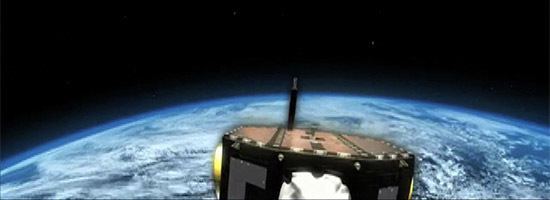
The design and operation of the mission is being led by the Southwest Research Institute, with the Los Alamos National Laboratory and the Lockheed Martin Advanced Technology Center serving as co-investigator institutions responsible for the IBEX-Hi and IBEX-Lo sensors respectively. The Orbital Sciences Corporation manufactured the spacecraft bus and was the location for spacecraft environmental testing. The nominal mission baseline duration was two years to observe the entire Solar System boundary. This was completed by 2011 and its mission was extended to 2013 to continue observations.
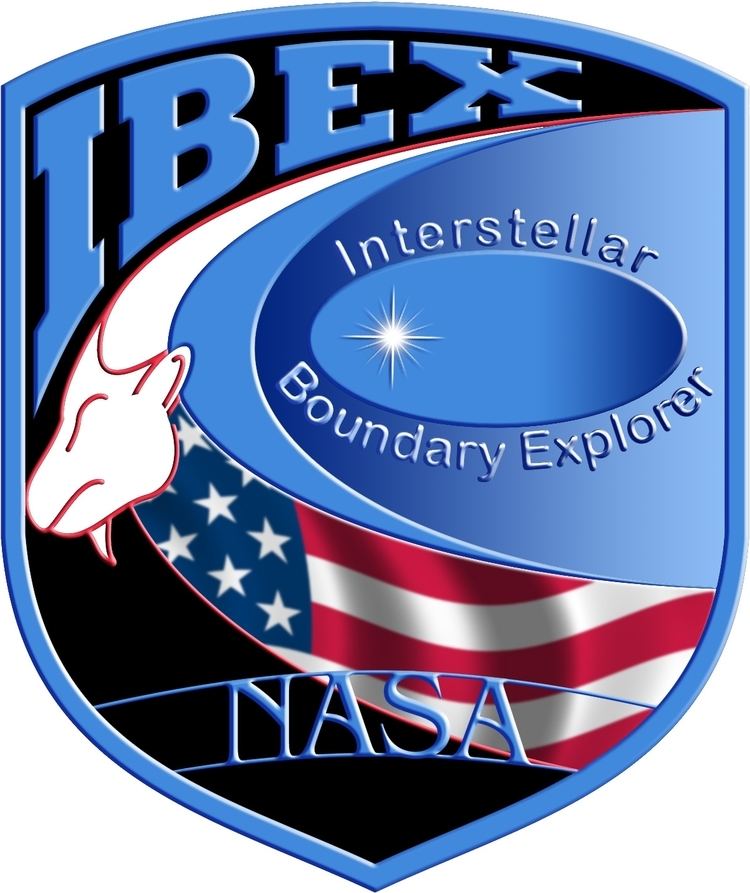
IBEX is in a Sun-oriented spin-stabilized orbit around the Earth. In June 2011, IBEX was shifted to a new more efficient orbit. It does not come as close to the Moon in the new orbit, and expends less fuel to maintain its position.
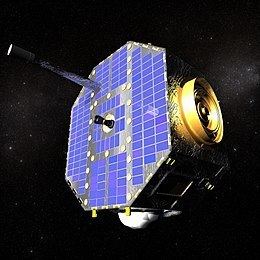
Interstellar boundary explorer
Payload
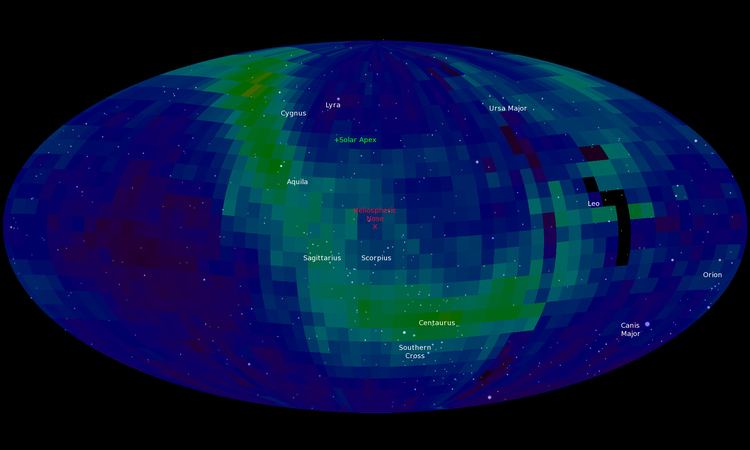
The heliospheric boundary of the Solar System is being imaged by measuring the location and magnitude of charge-exchange collisions occurring in all directions. This will ultimately yield a map of the termination shock of the solar wind. The satellite's payload consists of two energetic neutral atom (ENA) imagers, IBEX-Hi and IBEX-Lo. Each of these sensors consists of a collimator that limits their fields-of-view, a conversion surface to convert neutral hydrogen and oxygen into ions, an electrostatic analyzer (ESA) to suppress ultraviolet light and to select ions of a specific energy range, and a detector to count particles and identify the type of each ion. The IBEX-Hi instrument is recording particle counts in a higher energy band than the IBEX-Lo does. The scientific payload also includes a Combined Electronics Unit (CEU) that controls the voltages on the collimator and the ESA, and it reads and records data from the particle detectors of each sensor.
Mission parameters
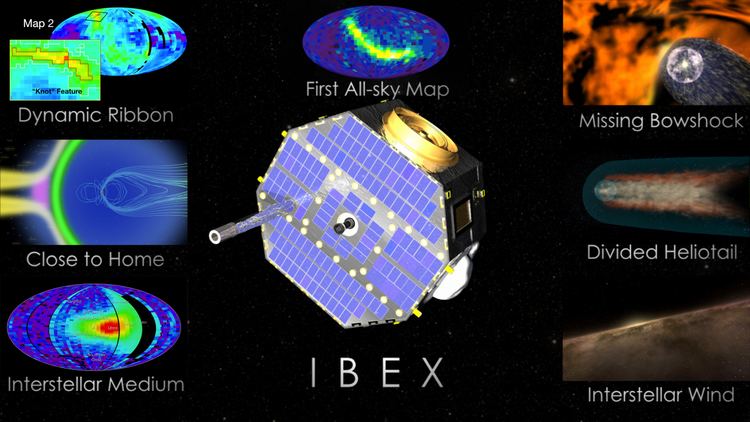
The IBEX satellite, initially launched into a highly-elliptical transfer orbit with a low perigee, used a solid fuel rocket motor as its final boost stage at apogee, in order to raise its perigee greatly and to achieve its desired high-altitude elliptical orbit.
IBEX is in a highly-eccentric elliptical terrestrial orbit, which ranges from a perigee of about 86,000 km (53,000 mi) to an apogee of about 260,000 km (160,000 mi). Its original orbit was about 7,000 by 320,000 km (4,300 by 198,800 mi)—that is, about 80% of the distance to the Moon—which has changed primarily due to an intentional adjustment to prolong the spacecraft's useful life (see Orbit adjusted below).
This very high orbit allows the IBEX satellite to move out of the Earth's magnetosphere when making scientific observations. This extreme altitude is critical due to the amount of charged-particle interference that would occur while taking measurements within the magnetosphere. When within the magnetosphere of the Earth (70,000 km or 43,000 mi), the satellite also performs other functions, including telemetry downlinks.
Launch
The IBEX satellite was mated to its Pegasus XL rocket at Vandenberg Air Force Base, California, and the combined vehicle was then suspended below the Lockheed L-1011 Stargazer mother airplane and flown to Kwajalein Atoll in the Central Pacific Ocean, a several-hours-long flight. Stargazer arrived at Kwajalein on Sunday, October 12, 2008.
The IBEX satellite was carried into space on October 19, 2008, by the Pegasus XL rocket. The rocket was released from Stargazer, which took off from Kwajalein, at 17:47:23 UTC. By launching from this site close to the Equator, the Pegasus rocket lifted as much as 16 kg (35 lb) more mass to orbit than it would have with a launch from the Kennedy Space Center in Florida.
Orbit adjusted
In June 2011 IBEX shifted to a new orbit that raised its perigee to more than 30,000 kilometres (19,000 mi). The new orbit avoids taking the spacecraft too close to the Moon, whose gravity can negatively affect IBEX's orbit. Now the spacecraft uses less fuel to maintain a stable orbit, increasing its useful lifespan to more than 40 years.
Data collection
IBEX is collecting energetic neutral atom (ENA) emissions that are traveling through the Solar System to Earth that cannot be measured by conventional telescopes. These ENAs are created on the boundary of our Solar System by the interactions between solar wind particles and interstellar medium particles.
On the average IBEX-Hi detects about 500 particles per day, and IBEX-Lo, less than 100. By 2012, over 100 scientific papers related to IBEX were published, described by the PI as "an incredible scientific harvest".
Astronomical results
Initial data revealed a previously unpredicted "very narrow ribbon that is two to three times brighter than anything else in the sky". Initial interpretations suggest that "the interstellar environment has far more influence on structuring the heliosphere than anyone previously believed". It is unknown what is creating the ENA (energetic neutral atoms) ribbon. The Sun is currently traveling through the Local Interstellar Cloud, and the heliosphere's size and shape are key factors in determining its shielding power from cosmic rays. Should IBEX detect changes in the shape of the ribbon, that could show how the heliosphere is interacting with the Local Fluff. It has also observed ENAs from the Earth's magnetosphere.
In October 2010, significant changes were detected in the ribbon after six months, based on the second set of IBEX observations.
It went on to detect neutral atoms from outside the Solar System, which were found to differ in composition from the Sun. Surprisingly, IBEX discovered that the heliosphere has no bow shock, and it measured its speed relative to the local interstellar medium (LISM) as 23.2 km/s (52,000 mph), improving on the previous measurement of 26.3 km/s (59,000 mph) by Ulysses. Those speeds equate to 25% less pressure on the Sun's heliosphere than previously thought.
In July 2013, IBEX results revealed a 4-lobed tail on the Solar System's heliosphere. The spacecraft has also imaged stellar-wind bubbles, called "astrospheres," around other stars, as well as the tails from these astrospheres.
Data transfer rate
Compared to other space observatories, IBEX has a low data transfer rate due to the limited requirements of the mission.
"... IBEX data transfer rates are slow compared with other telescopes due to the nature of the data it collects. IBEX does not need a "high speed" connection, since it only has the opportunity to collect up to a few particles per minute. Communication from the satellite to the ground is 20 times slower than a typical home cable modem (320,000 bits per second,) and from the ground to the satellite only 2,000 bits per second, which is 250 times slower! Once the signal is collected by the receivers on Earth it is carried over the internet to Mission Control Center in Dulles, VA and to the IBEX Science Operation Center in San Antonio, TX."
